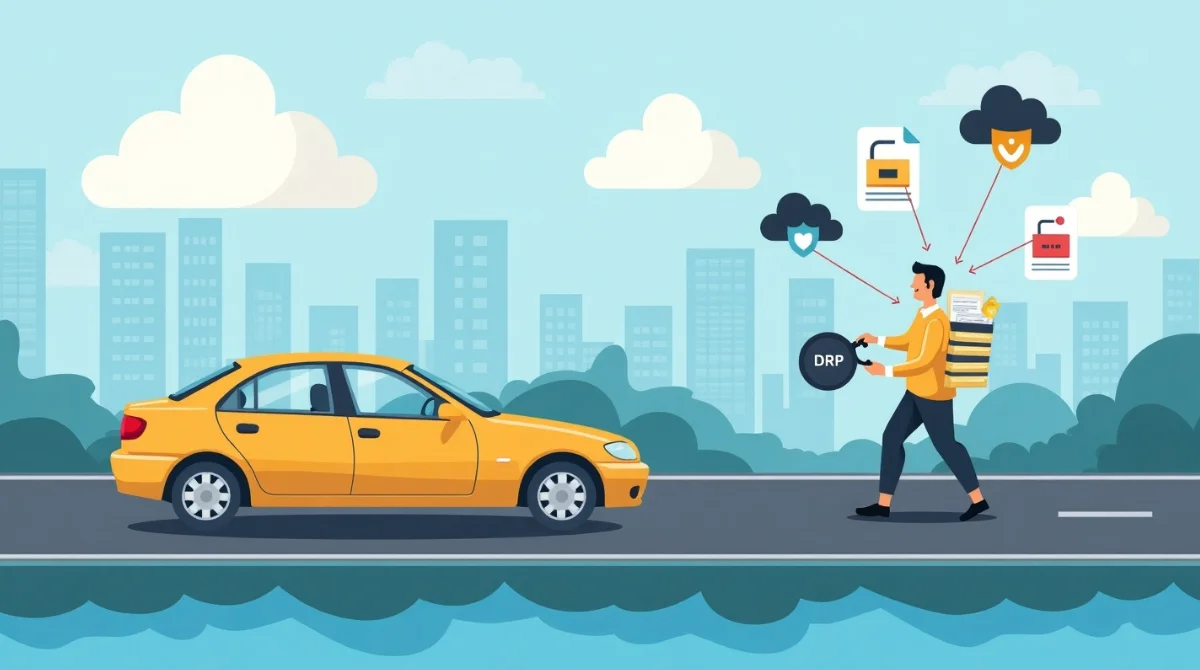In today’s digital world, businesses rely heavily on technology. But what happens when things go wrong? A Disaster Recovery Plan, or DRP, is like a safety net for your business. It helps you bounce back quickly from unexpected problems like cyberattacks, natural disasters, or system failures. Let’s break down what a DRP is, why it’s important, and how you can create one using simple, everyday language.
What is a Disaster Recovery Plan?
Imagine your business is a car. You wouldn’t drive without a spare tire or insurance, right? Similarly, a DRP is your business’s backup plan. It’s a set of steps and strategies designed to help you recover your IT systems and data after a disaster. Whether it’s a flood, a hacker attack, or a power outage, a DRP ensures you can get back on track with minimal disruption.
Why is a DRP Important?
A Disaster Recovery Plan (DRP) is like having a safety kit for your business. Just like you might keep a first-aid box at home or a spare tire in your car, a DRP is there to help your business stay safe and get back to normal if something unexpected goes wrong. Here’s a breakdown of why it’s so important:
1. Minimizes Downtime
Imagine if your computer or website suddenly stopped working. Every minute you’re offline, you’re losing customers, sales, or important work. A DRP helps you fix problems faster so your business doesn’t stay down for long. It’s like having a plan ready before a problem even starts.
2. Protects Data
Your business likely stores important information customer details, payment records, emails, documents, and more. If a system crashes or gets hacked, all that data could be lost. A DRP includes regular backups, so even if something bad happens, you still have a copy of everything important and can recover it.
3. Maintains Customer Trust
Customers expect businesses to be reliable. If your service suddenly stops and it takes days to fix, they might lose confidence in you. But if you recover quickly, it shows you’re prepared and professional. That keeps people loyal and reassures them that their data and needs are safe with you.
4. Ensures Compliance
Many businesses are required by law or industry rules to protect customer data and have recovery plans. For example, if you work in healthcare or finance, you may need to follow strict rules about how data is stored and recovered. A DRP helps make sure you’re following those rules so you don’t get fined or face legal trouble.
5. Reduces Financial Loss
Disasters can be expensive. Think about the cost of fixing broken systems, losing customers, or stopping your services for a few days. A DRP helps you respond faster, prevent bigger damage, and avoid losing a lot of money. It’s like investing in insurance it might cost a bit to create the plan, but it can save you a lot more in the long run.
Key Components of a DRP
Creating a DRP might seem daunting, but breaking it down makes it manageable. Here’s what you need:
1. Risk Assessment
Start by identifying potential threats. These could be:
- Natural disasters like floods or earthquakes.
- Cyberattacks or data breaches.
- Hardware failures or power outages.
Understanding these risks helps you prepare for them.
2. Business Impact Analysis
Determine how these risks could affect your business. Ask questions like:
- Which systems are critical for operations?
- How long can we afford to be offline?
- What data is essential?
This analysis helps prioritize recovery efforts.
3. Recovery Objectives
Set clear goals:
- Recovery Time Objective (RTO): How quickly should systems be restored?
- Recovery Point Objective (RPO): How much data loss is acceptable?
These objectives guide your recovery strategies.
4. Backup Strategies
Regular backups are vital. Consider:
- Frequency: How often should data be backed up?
- Storage: Where will backups be stored? On-site, off-site, or in the cloud?
- Testing: Regularly test backups to ensure they work.
5. Recovery Procedures
Document step-by-step instructions for restoring systems and data. This includes:
- Who is responsible for each task?
- What tools and resources are needed?
- How to communicate during recovery?
Clear procedures ensure a smooth recovery process.
6. Communication Plan
In a disaster, communication is key. Your plan should outline:
- Who communicates with employees, customers, and stakeholders?
- What information needs to be shared?
- How will updates be provided?
Effective communication reduces confusion and maintains trust.
7. Training and Testing
Regular training ensures everyone knows their role during a disaster. Conduct drills and simulations to test the plan’s effectiveness. Update the plan based on lessons learned.
Steps to Create Your DRP
Creating a DRP isn’t something you can do overnight. It takes planning and teamwork, but once it’s done, your business will be much better prepared for any kind of emergency. Let’s walk through the steps one by one using easy-to-understand words.
1. Assemble a Team
Start by gathering the right people. You’ll need help from different departments, especially the IT team, since they handle the technical stuff. But you also need input from managers and others who understand how the business works. Everyone brings a different view, which helps make the plan complete and practical.
2. Conduct Risk Assessment and Business Impact Analysis
Now, think about all the bad things that could happen. What if there’s a fire, flood, hacking attempt, or a power failure? These are your risks. After listing them, look at how each one could affect your business. That’s your impact analysis. You’ll figure out which parts of your business are most important and how badly they’d be affected by different disasters.
3. Define Recovery Objectives
Once you know the risks and impacts, set some clear goals:
- RTO (Recovery Time Objective): This means how fast you need to get systems up and running again. For example, do you need your email back in 1 hour or can it wait 1 day?
- RPO (Recovery Point Objective): This tells you how much data you can afford to lose. For instance, if your last backup was 4 hours ago, are you okay losing that 4 hours of data?
These two points help you decide how fast and how much you need to recover.
4. Develop Backup and Recovery Strategies
Now it’s time to decide how you’ll get your systems and data back. You need backup systems. That means regularly saving copies of your data and files, either to the cloud, to external hard drives, or even to a secure off-site location. You should also write down the exact steps for recovering everything if something fails. This makes recovery smooth instead of stressful.
5. Establish Communication Plan
During a disaster, everyone needs to know what’s happening. That’s why you need a communication plan. This includes:
- Who will talk to employees, customers, and other partners?
- How will updates be shared by email, phone, website, or social media?
- What kind of message will be sent and who needs to approve it?
Clear communication helps avoid panic and confusion.
6. Document Everything
This step is simple but very important. Write down the entire plan clearly in one document. This is your official DRP file. It should include everything contacts, backup locations, recovery steps, timelines, roles, and more. Keep copies safe and make sure all key people can access them, even during an emergency.
7. Train and Test
A plan is only good if people know how to use it. That’s why you need to:
- Train your team: Make sure everyone knows what their job is during a disaster.
- Test the plan: Run mock drills, like pretend disasters, to see if the plan works. If something goes wrong during testing, improve it.
This helps you catch problems before a real emergency happens.
By following these steps, you build a strong, smart recovery plan that protects your business from major damage. It’s all about being prepared not panicking,and making sure your business can survive anything from a power cut to a cyberattack.
Common Mistakes to Avoid
Creating a DRP is a smart move, but it’s just as important to avoid some common mistakes that can weaken your plan. Let’s go over a few things people often get wrong, and why these mistakes can cause big problems later.
1. Neglecting Regular Updates
Technology changes fast. Your business also grows, adds new tools, hires new staff, and updates systems. If your DRP stays the same for years, it might not match your current setup. For example, if you switched to cloud storage but your DRP still mentions old servers, that could delay recovery. That’s why you need to review and update your plan regularly every few months or at least once a year so it stays useful and accurate.
2. Overlooking Employee Training
Even the best-written plan won’t work if your team doesn’t know what to do. One big mistake is assuming people will “figure it out” during a crisis. That usually leads to panic and confusion. All staff should know their role in the plan. For example, if someone is in charge of sending out customer emails during a disaster, they should be trained to do it smoothly. Hold training sessions and make sure everyone understands their part.
3. Ignoring Small Risks
It’s easy to focus only on major disasters like floods or cyberattacks. But smaller problems, like a power outage, internet failure, or even a broken printer can also stop your work and cause delays. These “small” risks can build up and turn into bigger issues if not handled quickly. A complete DRP should cover both big and small threats so you’re ready for anything.
4. Failing to Test the Plan
Writing your DRP is just the first step. If you never test it, you don’t really know if it works. Testing means running drills, pretend emergencies where you follow the plan and see what happens. This helps you spot any problems, like missing information, unclear roles, or slow response times. It’s much better to find those issues during a test than during a real disaster. Testing also gives your team confidence because they’ll know exactly what to do.
Types of DRP

Not all businesses are the same, and neither are their disaster recovery needs. That’s why there are different types of Disaster Recovery Plans, each designed for specific situations and setups. Choosing the right type depends on how your business uses technology, where your data is stored, and how quickly you need to recover after a problem. Let’s look at the most common types of DRPs.
1. Data Center Disaster Recovery
This type of DRP focuses on physical locations where your company’s servers, computers, and hardware are stored often called data centers. If there’s a fire, flood, power failure, or break-in at that location, this plan helps protect and recover the equipment and the data it holds. It includes steps like having backup power generators, duplicate servers at another site, or cloud-based backups.
2. Cloud Disaster Recovery
Many businesses now use cloud services like Google Drive, Dropbox, or cloud-based software platforms. A Cloud DRP focuses on restoring access to data and systems stored in the cloud. The big benefit here is flexibility. Even if your physical office is damaged, your team can still access files online from anywhere. This type of DRP also allows you to quickly restore virtual systems instead of rebuilding physical servers.
3. Virtualized Disaster Recovery
This type of plan uses virtual machines (VMs) software that acts like a real computer inside your system. Virtual DRPs make it easier and faster to recover because you can copy a virtual machine, restart it on a new server, and keep working without much delay. It’s cost-effective and works well for companies that rely on virtual environments.
4. Network Disaster Recovery
A Network DRP focuses on your company’s internal and external communication systems, things like internet, email servers, routers, firewalls, and VPN connections. If your network goes down, employees might not be able to work, especially if you have remote workers or cloud systems. This plan makes sure your team can stay connected and secure even when something breaks in the network.
5. Application Disaster Recovery
This type of DRP is all about recovering specific software and applications that your business depends on like customer management software, accounting tools, or online shopping platforms. If just one of these tools crashes, it can cause big problems. This plan includes instructions to reinstall or restore the apps, recover saved settings, and ensure users can log in again quickly.
6. Business Continuity Plan (BCP)
While not strictly a DRP, a Business Continuity Plan goes hand-in-hand with disaster recovery. It’s a broader strategy that includes all areas of your business not just IT. So if a disaster happens, this plan helps your business keep running overall. It might include remote working policies, customer support strategies, and supply chain adjustments.
How to Choose the Right DRP Type
You don’t need all types of DRPs, but you might need more than one depending on your business. Here’s how to decide:
- If you store most of your files online → focus on Cloud DRP
- If your work depends on apps and software → add Application DRP
- If you have physical servers → include Data Center DRP
- If your team works remotely or online → consider Network DRP
- If you use virtual systems → go for Virtualized DRP
- If you want full business protection → combine with a Business Continuity Plan
Conclusion
A Disaster Recovery Plan is essential for any business that relies on technology. It prepares you for the unexpected and ensures you can recover quickly, protecting your data, reputation, and bottom line. By understanding the components and steps involved, you can create a DRP that keeps your business resilient in the face of adversity.




Your positive and uplifting words are like a ray of sunshine on a cloudy day Thank you for spreading light and positivity in the world
I have recommended this blog to all of my friends and family It’s rare to find such quality content these days!